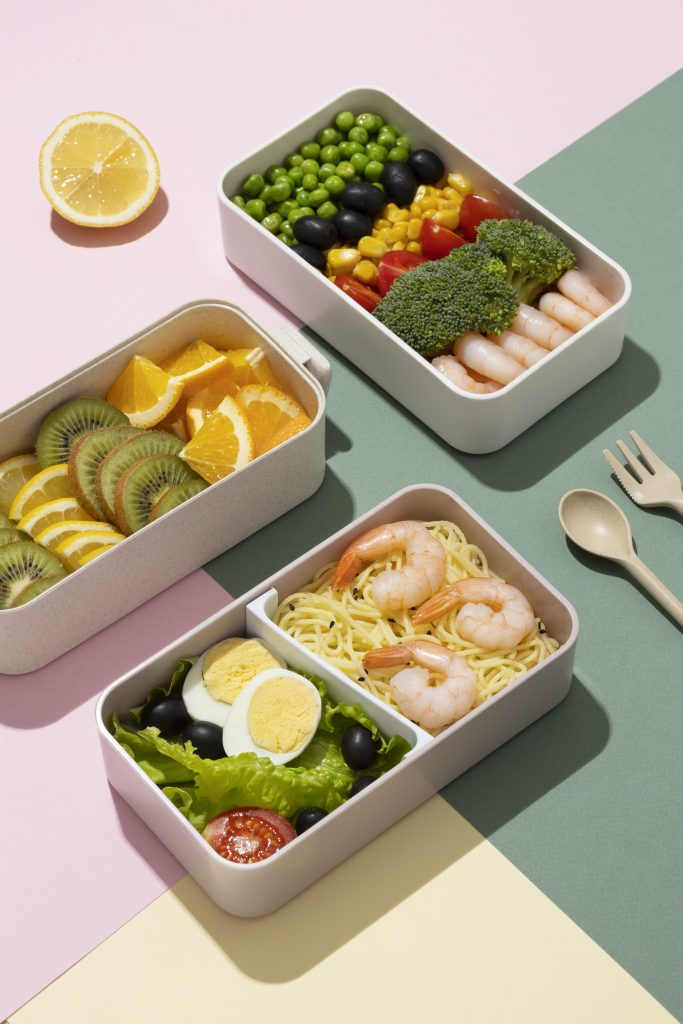Simply put, a bento is a single-serving lunch that is packed and carried by the diner already assembled together and ready to be enjoyed. Definitely a lot more like an American lunch box.
Bento typically has rice or noodles as the primary starch, along with one or more proteins such as meat, fish, or eggs. An assortment of cooked and pickled vegetables, paired with a couple of pieces of fruit, balance these two main focal points to create a well-balanced meal that is perfect for eating healthily while traveling. Western culinary styles may be a source of inspiration for modern bentos, which often include fried potatoes, green salads, dairy products, sandwiches, desserts, and so on.

As a colloquial phrase from Southern Song Chinese, “bento” means “convenient,” but don’t let that deceive you— Bentos are inventions that make life much simpler for the recipient, but the people who create them typically put a lot of love and effort into making them. Bento is an ancient art style that emerged in the 1100s. Bento as a concept can be traced back to the Kamakura period (1185–1333) in Japan when workers used to carry cooked rice in a little bag to work. However, bento as we know it did not exist until the Azuchi-Momoyama period, which stretched from 1568 to 1600.
At that time, lacquered wood boxes emerged as Japan’s classy approach to the picnic basket. Carrying a meal was made beautiful as well as useful by the labor-intensive and potentially hazardous skill of urushi (raw liquid lacquer is harmful to the touch; its fumes, are poisonous).
It is said that the Japanese eat with their eyes. It makes sense then that in traditional Japanese culture plating and presentation are crucial.
FoodandDrinkresources.com
Bentos are making a huge comeback today in both Japan and the US, thanks to fresh ideas and styles. and a renewed appreciation for a long-standing custom that makes desk lunches anything but sad.
The school lunch notion of bento boxes is still very much in style. Using a multiple-compartment system, this popular method of packing school lunches is a great way for kids to get in a more nutritious meal. Leak resistance is a further advantage that most bento boxes have, which is a big plus. This excellent feature of this type of lunch box contributes to keeping food from leaking or spilling. Because food can be simply arranged and rearranged into various divisions thanks to the multiple compartments, they are also environmentally friendly because they minimize the need for foil wrap or plastic baggies.
Bento lunch boxes are aesthetically pleasing and available in a wide variety of colors, designs, and sizes. They can be larger and have multiple compartments, or smaller and include three compartments. Furthermore, they can also be stackable and contain two or three stackable containers, each of which can be further divided into individual compartments.
Considering many parents and children prefer to eat separately, bento box lunchboxes are becoming increasingly prevalent in a number of households. Additionally, bento boxes do not function like regular plates or boxes. Variety, after all, is what makes life interesting.
Bento boxes are practical. Have a look at the snack line Lunchables. By keeping the grain, protein, and dairy separated from one another, Kraft Heinz manages to make it work. The food holds its original flavor and texture.
Article by Vanshita Kanjani | Edited by Saumya Sharma


